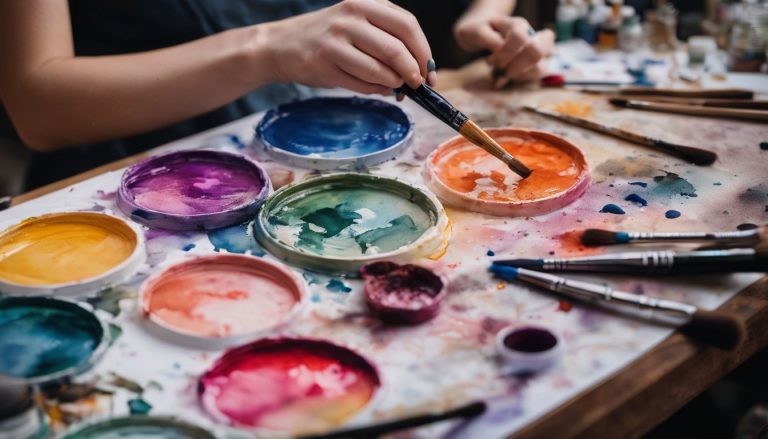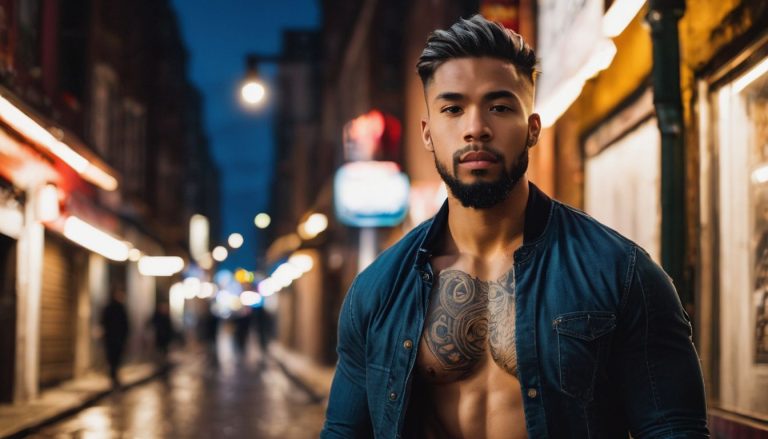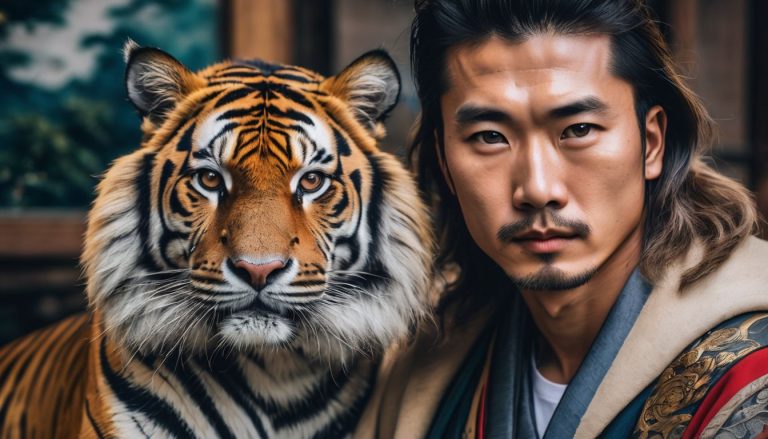Exploring the Meaning and Symbolism Behind Smiley Face Tattoos
Create your own unique tattoos and art for your home
Tattoos tell a story and we often wonder about the tales behind those cheerful smiley faces inked on skin. The iconic smiley face first flashed its bright yellow grin in the 1960s, symbolizing happiness and peace.
This blog will uncover why people choose this joyful symbol as tattoos, revealing meanings that go beyond just a simple smile. Keep reading to discover the smiles and stories these tattoos hold!
Key Takeaways
- Smiley face tattoos originated in the 1960s, symbolizing happiness and optimism, and have evolved to represent resilience, individuality, and the overcoming of struggles.
- The design has been adopted widely, from minimalistic symbols of joy to vibrant declarations of personal expression through colored interpretations or added elements like X-eyed variations.
- Placement on different body parts adds unique meaning; a smiley face tattoo on the wrist might signify positivity with every hand movement whereas behind the ear could be a reminder for inner happiness.
- Celebrities like Justin Bieber and Miley Cyrus sport smiley face tattoos that reflect their journeys, challenges, and positive outlooks on life while influencing cultural trends.
- While often associated with joy and positivity, these tattoos also embody nostalgia for eras like the retro ’60s vibe or ’90s rave culture alongside personal stories of resilience.
What are Smiley Face Tattoos?
Smiley face tattoos are a popular form of body art that features the iconic yellow smiley face symbol. Originating from the 1960s, this symbol has evolved into a timeless and recognizable image, often representing positivity, joy, and happiness.
These tattoos have become a significant part of tattoo culture and hold various meanings for those who choose to ink them on their bodies.
History of smiley face symbol
The classic smiley face started its journey as a symbol of happiness and optimism in the 1960s. An artist named Harvey Ball created this iconic image with a bright yellow background, two black dots for eyes, and an upturned curve representing a mouth.
It quickly became popular, flooding the American culture with a message of cheerfulness and positivity.
Years later, in the late ’90s, rave culture embraced the smiley face once again, infusing it into fashion and music scenes. The Nirvana band logo featured a unique version with X-ed out eyes which stirred controversy; some fans theorized that it was linked to an obscure strip club in Seattle.
Over time, this symbol has maintained its status as an emblem for happiness while also becoming associated with more complex themes like resilience and individuality.
Evolution of smiley face tattoos
After understanding the history and significance of the smiley face symbol, it’s intriguing to delve into the evolution of smiley face tattoos. The classic symbol has evolved from its early association with optimism in the 1960s to becoming a popular choice for tattoo artistry in late 90s rave culture.
Notably, x-eyed smiley face tattoos have gained prominence for their representation of life paradoxes, individuality, and mortality. The cultural context is vast as facial tattoos adorned by women in Bedouin tribes signify beauty and social status.
This diverse evolution showcases how smiley face tattoos have transcended time and cultures to become powerful symbols of personal expression.
With an array of interpretations and designs, smiley face tattoos serve as a reminder of resilience amid life’s light and dark moments. Additionally, these tattoos can hold deep personal meanings; they represent introspection, reminding wearers about their individual perspectives and values.
The Meaning and Symbolism Behind Smiley Face Tattoos
Smiley face tattoos represent positive vibes, happiness, and the ability to overcome struggles. They also symbolize nostalgia, retro fashion, personal expression, and individuality.
Positive vibes and happiness
Smiley face tattoos radiate positive vibes and happiness, symbolizing joy and optimism. The classic yellow smiley with its cheerful grin is a timeless representation of light-heartedness and positivity, often reflecting an individual’s sunny disposition or their commitment to staying upbeat despite life’s challenges.
In ancient cultures, facial tattoos were believed to harness the power of positive energy and divert negative forces, much like the contemporary symbolism behind smiley face tattoos.
Whether through a simple design or a vibrant color palette, these tattoos serve as visual reminders to focus on the brighter side of life.
Overcoming struggles and difficulties
In addition to symbolizing positive vibes and happiness, smiley face tattoos can also serve as a powerful reminder of resilience in the face of struggles and difficulties. From personal challenges to societal obstacles, these tattoos can represent an individual’s triumph over adversity.
For example, smiley face tattoos with X eyes not only reflect introspection and individuality but also signify the wearer’s ability to overcome personal struggles.
Furthermore, historical cultural practices such as adorning facial tattoos among women in Bedouin tribes highlight the significance of overcoming challenges while embracing one’s identity.
Nostalgia and retro fashion
Nostalgia and retro fashion play a significant role in the popularity of smiley face tattoos. The classic symbol reminds many individuals of the carefree and joyful spirit of previous generations, stoking feelings of nostalgia for the 1960s and late 90s rave culture.
This trend resonates with those who appreciate vintage aesthetics and find comfort in reviving iconic symbols from bygone eras, reflecting a timeless appeal that transcends generational boundaries.
Additionally, smiley face tattoos tap into the resurgence of retro fashion trends, aligning with society’s ongoing fascination with revisiting styles from decades past.
Personal expression and individuality
Transitioning from the nostalgic appeal of smiley face tattoos to their role in personal expression and individuality, these tattoos serve as powerful symbols of individual perspectives and values.
With a myriad of meanings, from joy to resilience, a smiley face tattoo reflects the wearer’s unique outlook on life. The incorporation of x eyes into the traditional design adds depth to its symbolism, representing introspection and the complexities of human experiences.
These tattoos also offer a form of self-expression that transcends language barriers, allowing individuals to convey their emotions and inner truths. Embracing contradictions such as lightness amidst darkness or happiness through struggles, wearers use smiley face tattoos as visual declarations of their personal journeys and beliefs.
Different Designs and Placements of Smiley Face Tattoos
Smiley face tattoos come in various designs, from minimalist to colorful, and can be placed on different body parts for personal expression and individuality. If you want to learn more about the diverse world of smiley face tattoos, keep reading!
Small and minimalist designs
Smiley face tattoos with small and minimalist designs have gained popularity for their subtle yet impactful appearance. These designs often convey a sense of understated style and personal significance, making them a popular choice for many individuals.
- Minimalist smiley face tattoos typically feature simple lines and minimal details, creating a clean and refined look that appeals to those seeking a discreet yet meaningful tattoo.
- Small smiley face tattoos are often placed on delicate areas such as behind the ear, wrist, or finger, allowing for a subtle yet symbolic expression of positivity and joy.
- Many individuals opt for minimalist smiley face tattoos as a way to showcase their unique personality while maintaining a sleek and timeless aesthetic.
- Despite their small size, these minimalist designs hold deep significance and can represent individuality, optimism, and the enduring importance of positivity in one’s life.
- The versatility of small and minimalist smiley face tattoos allows for creative placement options that align with the wearer’s preferences and personal meaning.
Colorful and vibrant designs
Vibrant and colorful designs of smiley face tattoos are visually striking and expressive. These designs often incorporate a range of bright hues to convey a sense of liveliness and energy. This style can include:
- Bold rainbow – colored smiley faces that symbolize diversity, inclusivity, and positivity.
- Neon or fluorescent ink used to create an eye – catching glow effect, representing the vibrancy of life and joy.
- Incorporation of intricate patterns or abstract shapes within the smiley face, adding complexity and depth to the design.
- Floral or nature – inspired elements entwined with the smiley face, evoking themes of growth, beauty, and vitality.
- The use of contrasting colors to create dynamic visuals that reflect the complexity of human emotions and experiences.
Placement on different body parts
Smiley face tattoos can be placed on various body parts, each carrying its own significance and impact:
- The wrist: A popular location for smaller smiley face tattoos, symbolizing positivity and happiness with every movement of the hand.
- The back of the ear: A discreet placement, representing joy or a reminder to always listen to one’s inner happiness.
- The neck: Often signifies a balance between expressing happiness and personal discretion, serving as a subtle yet meaningful tattoo placement.
- The finger: Represents a constant visual reminder of joy and optimism in daily life, reflecting individuality through minimalistic designs.
Celebrities with Smiley Face Tattoos
Celebrities like Justin Bieber, Cara Delevingne, Miley Cyrus, and Harry Styles have all sported smiley face tattoos, each with their own unique designs and placements. These celebrities have used their smiley face tattoos to express their individuality and spread positivity.
Justin Bieber
Famous pop star Justin Bieber sports a small smiley face tattoo near the corner of his right eye. The tattoo is often associated with the singer’s journey and personal struggles, symbolizing resilience and overcoming obstacles.
This meaningful ink choice reflects Bieber’s positive outlook on life, as he navigates through the highs and lows of fame.
Bieber’s x-eyed smiley face tattoo serves as a constant reminder of self-reflection and individuality. The symbolism behind his iconic tattoo aligns with themes of positivity, joy, and inner strength that resonate deeply with his fans.
Cara Delevingne
Cara Delevingne, a well-known model and actress, proudly sports a smiley face tattoo on her right ear. This small yet striking tattoo is a symbol of her vibrant personality and positive outlook on life.
With bold confidence, Cara embraces the meaning of her smiley face ink – exuding joy, optimism, and individuality with every appearance.
A true trendsetter in the world of fashion and body art, Cara’s smiley face tattoo complements her free-spirited persona. By choosing this specific design as one of many tattoos adorning her body, Cara showcases personal expression and resilience in overcoming both public scrutiny and private struggles.
Miley Cyrus
Transitioning from the notable smiley face tattoos of Cara Delevingne, Miley Cyrus also boasts a striking smiley face tattoo. The renowned musician and actress displayed her cheerful personality with a small yellow smiley tattoo inked on her left ankle.
This simple yet bold design perfectly encapsulates the positive energy and carefree spirit that is often associated with the symbol. Miley’s choice to have this particular tattoo echoes the notion of embracing happiness and spreading joy, in line with her advocacy for causes like Happy Hippie Foundation, making it an inspiring emblem of optimism and resilience.
Miley Cyrus’ expressive body art reflects her commitment to using her platform as a means of sharing positivity and love while advocating for issues close to her heart. Inking such an iconic symbol onto one of the most visible parts of her body speaks volumes about celebrating happiness and individuality, while also serving as a reminder that even amidst life’s challenges, there is always room for joy and hope.
Harry Styles
Transitioning from the world of celebrity smiley face tattoos, Harry Styles proudly showcases his own iconic ink. Known for his bold fashion choices and artistic expression, Harry has a small black smiley face tattooed on the inside of his left arm.
This simple yet meaningful design reflects his commitment to positivity and individuality. Just like other celebrities with similar tattoos, Harry’s choice to ink a smiley face serves as a reminder of joy and personal values, connecting him to the cultural significance of this universal symbol.
As an influential figure in music and fashion, Harry Styles’ smiley face tattoo reinforces the symbolism behind this timeless image. With its subtle placement, it embodies the essence of happiness and self-expression that resonates deeply with fans across the globe.
Conclusion
Exploring the Meaning and Symbolism Behind Smiley Face Tattoos leads to a captivating journey through personal expression. Understanding the diverse symbolism of smiley face tattoos enriches our perception of this popular tattoo design.
The cultural significance of smiley face tattoos spans decades and continues to evolve, reflecting individual experiences and values. Delving into the meaning behind smiley face tattoos unveils a tapestry of emotions, resilience, and unique perspectives.
Embracing the rich symbolism embodied by smiley face tattoos offers an opportunity for self-expression and connection with others who share similar values.
FAQs
1. What do smiley face tattoos represent?
Smiley face tattoos often symbolize happiness, positivity, and a cheerful outlook on life, embodying joyful emotions and optimistic vibes.
2. Can smiley face tattoos have different meanings?
Yes, while typically representing happiness, smiley face tattoos can also express a person’s unique connection to joy or an important reminder to stay positive.
3. Are there specific designs for smiley face tattoos?
There are many designs for smiley face tattoos ranging from the classic yellow emoticon tattoo to more artistic variations that include symbols of happiness or the Happy Hippie Foundation logo.
4. Where do people usually get smiley face tattoos?
People commonly choose visible areas like the hand for their happy face tattoo but they can be placed anywhere on the body depending on personal preference.
5. Is it popular among both men and women to get a smiley face tattoo?
Absolutely! Smiley face tattoo designs appeal to everyone regardless of gender; both male and female individuals often choose these symbolic tattoos as expressions of their emotions.









